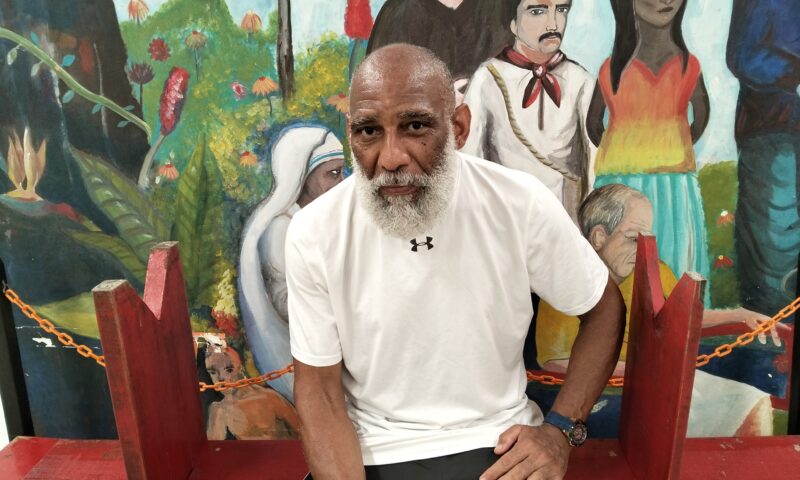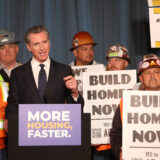Ballot Bullies
Ballot Bullies: How Corporations Learned to Love Direct Democracy
It’s been 105 years since California voters were granted, by a progressive governor and his forward-thinking allies, the right to make laws at the ballot box. We were not the first to gain the privilege; 11 states got there first. Today 24 states allow for direct legislation, which they exercise with varying degrees of intensity when the need arises.

It’s been 105 years since California voters were granted, by a progressive governor and his forward-thinking allies, the right to make laws at the ballot box. We were not the first to gain the privilege; 11 states got there first. Today 24 states allow for direct legislation, which they exercise with varying degrees of intensity when the need arises.
But no state quite matches the high-roller financial showdown that happens every election season in California. Our ability to attract big spenders on the initiatives, referenda and state constitutional amendments that confront an increasingly confused electorate is unparalleled. As of mid-October, more than $400 million had been spent on the 17 measures on the 2016 California ballot. Compare that with Colorado, which ranks second in ballot measure campaigns and whose seven initiatives and two referenda this year cost donors a total of $67 million, a “high-water mark” according to the Colorado Independent.
This was not what John Randolph Haynes had in mind at the end of the 19th century, when he fought to bring citizen lawmaking to the people. A thoughtful humanist with bold progressive ideas about how to preserve democracy, Haynes came to California from Pennsylvania’s coal county in 1887 to find the state legislature in the thrall of the Southern Pacific Railroad Company. Every shred of legislation proposed in Sacramento had to pass muster with the railroad oligarchs; politics were dominated by scoundrels.
More than 20 years later, Haynes’ solution, known back then as “direct democracy,” was intended, in the words of Governor Hiram Johnson, to “eliminate every private interest from the government, and to make the public service of the State responsive solely to the people.” Among its early victories was the abolition of the poll tax—certainly a win for the common man. Less than a century later the ballot initiative and referendum process had become, in the words of journalist David Broder, “not only a radical departure from the Constitution’s system of checks and balances, it is also big business,” a playground for millionaires and corporations that view initiative campaigns as a far less cumbersome means of achieving their various agendas than lobbying legislators to pass their bills.
Over the next few days, Capital & Main writers will examine some major issues that are part of the 17 measures on the November ballot in order to take a hard look at corporate influence over California’s ballot-box legislation:
- Dean Kuipers looks at the perennial muscle of the tobacco industry, exercised this year over Proposition 56, which seeks an additional $2 tax on each pack of cigarettes;
- Judith Lewis Mernit writes about the deceptive setup that might cause California voters to veto a state law to ban single-use plastic bags even though 60 percent of those polled support it;
- Jim Crogan tallies up the enormous contributions Big Pharma has made to oppose Proposition 61, an initiative to control state agencies’ prescription drug costs;
- Plus illustrations by Lalo Alcaraz (see above and here), videos and infographics.
All of the measures we will explore have brought in big money: Pharmaceutical companies have ponied up $109 million to oppose Prop. 61; the tobacco industry has doubled down with $66 million to quash the first cigarette tax in 18 years. And four out-of-state corporations banded together to sink $6 million to overturn a state law passed in 2014 that would ban single-use plastic bags.
Part of the reason wealth concentrates in ballot-box lawmaking is that unlike candidate races, there are no limits on contributions made to initiative campaigns; the U.S. Supreme Court ruled in 1981 that any such restrictions would violate the First Amendment’s guarantee of free association. Another part is the price of admission—simply gathering sufficient signatures to get a state or amendment on the ballot costs at least $2 million and as much as $6 million, depending on deadlines, timing and the aggressiveness of a campaign.
That pretty much counts out any middle-class activist with an eye on citizen lawmaking. It also gives outsized power to billionaires with big ideas. “A single individual with deep pockets and a pet project can almost single-handedly get an initiative on the ballot,” says Kim Alexander, who established the California Voter Foundation in 1994 to foster a better-informed electorate. And even that single individual can be outspent, in a game of one-upmanship that ends only when one side runs out of cash. Witness Los Angeles real estate developer Steve Bing’s 2006 bid to establish a tax on oil-and-gas extractors. Bing bankrolled his $61 million Proposition 87 campaign with $50 million of his own money, but the oil and gas industry spent more— $94 million—and prevailed. It was, at the time, the most money ever spent on an initiative campaign.
Money, however, isn’t everything. “Just as it’s not possible to get an initiative on the ballot without money, it’s also not possible to win a campaign with only money,” Alexander says. Pacific Gas & Electric, for instance, in 2010 spent $46 million to effectively outlaw community power companies; the opposition spent less than $100,000, and won.
In fact, most propositions, no matter how generously supported, fail in California, says Shaun Bowler, a political science professor at the University of California, Riverside, and author of Demanding Choices: Opinion Voting and Direct Democracy. And plenty of high-stakes opposition campaigns go down, too, which might make the investment in California’s ballot-box governing look dubious to the casual observer.
Anyone, however, who wants to have an influence in national politics, be it industrial lobbyist or environmental activist, ignores California at their peril. “California is massive,” Bowler says. “It’s the fifth-largest economy in the world. We’re bigger than Canada, bigger than Italy.” Standards and regulations adopted in California become national standards; technologies developed to meet California rules are adopted throughout the nation.
There are also reasons for participating in California’s direct democracy that have nothing to do with winning, Bowler says: “Individuals and interest groups spend money in California, basically, because they can.” It’s a place where they have an opportunity to make their presence known, to remind people that they matter.
“It’s a little bit like being in a bar fight,” Bowler says. “To prove you’re the tough guy, you kick someone’s dog outside. You’re letting people know you’re in the game.”
Another practiced strategy is to use the initiative process to bleed opponents white, rendering them weakened or even useless for future combat. That’s what happened in 1998, when anti-tax crusader Grover Norquist orchestrated a campaign to force California unions to obtain annual written permission from each and every member before spending a penny on political action. “Paycheck Protection” measures like Proposition 226, Norquist crowed, would “crush labor as a political entity,” and cash flowed in from across the country to support his California foray. Richard Mellon Scaife, the oil-invested billionaire in Pittsburgh, Pennsylvania; Indiana insurance tycoon J. Patrick Rooney; and even Bristol-Myers Squibb, the New York City-based medical supply conglomerate, added tens of thousands of dollars to the half million supplied by Norquist’s anti-tax advocacy outfit, Americans for Tax Reform, headquartered in Washington, D.C.
Thanks to a vigorous grassroots counter-campaign by the California Labor Federation and the AFL-CIO, Prop. 226 was rejected by 53 percent of voters. Norquist, however, still called it a win. After all, proponents of 226 had spent just $6.5 million, but they’d forced the labor movement to sink more than $24 million into fighting them— almost as much as the AFL-CIO had spent in 1996 on its entire slate of U.S. congressional candidates.
“Even when you lose,” Norquist boasted to a 1999 conference in Washington, D.C., “you force the other team to drain resources for no apparent reason.” Labor, he argued, had been severely diminished as a political force heading into the November election. (In the presidential year 2012 a like-minded initiative, Proposition 32, also forced labor to outspend the ballot measure’s backers, by $73 million to $60 million.)
In the short term, that was probably true. But over the long term, the Prop. 226 battle paid off exactly as AFL-CIO field organizer Ken Grossinger said it would, when he wrote about it in 1998. Beating back an initiative that would have hobbled labor’s political clout in California, he argued, shored up the grassroots base, galvanizing labor’s political forces. In the same way, Republicans under Governor Pete Wilson watched their fortunes decline after 1994, as the state’s sizable Latino population mobilized against Proposition 187, an initiative that would have denied undocumented immigrants public services. Both labor and Latinos, politically engaged, helped turn California a deeper shade of blue.
John Randolph Haynes and Hiram Johnson, had they lived to see it, might be horrified at direct legislation’s descent into a special-interest cash contest. But they wouldn’t be surprised, says Daniel A. Smith, a political science professor at the University of Florida-Gainesville, and the co-author of Educated by Initiative: The Effect of Direct Democracy on Political Organizations in the American States. “The initiative process in California has never been a purely amateur mechanism to alter public policy,” he says. “People decry the amount of money, the special interests involved in ballot campaigns, but corporate interests realized very quickly that they could play the game, too.”
Smith says the “really strong irony” is that Johnson himself inspired early 20th century industrialists to take up the game. “Progressives took over the government,” he says, closing off industry’s former avenue of influence. Moneyed interests then took advantage of the very mechanism progressives had created for the people, only to achieve their own corporate agendas. As early as 1922, so much money was spent on initiative campaigns that the state senate convened a special investigation to look into the issue. “The power of money” over direct legislation, they found, “was made strikingly manifest.”
But the power of money wasn’t enough to move those same senators to end the citizen lawmaking process, and none likely will. For all their gripes, California voters actually like their ballot-box governing. “California voters are deeply protective of their rights,” Kim Alexander says. “As much as people like to complain about it, California voters don’t want to see their right to make laws directly through the ballot eroded.”
The most worthy thing we can all do, then, to safeguard the intent of direct democracy is to exploit the state’s robust transparency laws—“the best in the country,” Alexander attests—to understand exactly what each of our votes will mean.
“We have much more information as voters in California than anywhere else in the world,” she says. “We have much more power, too. If California voters understand that power, every November is an awesome opportunity.” But only if we know what we’re doing.

-

 Latest NewsNovember 19, 2025
Latest NewsNovember 19, 2025How Employers and Labor Groups Are Trying to Protect Workers From ICE
-

 Latest NewsNovember 18, 2025
Latest NewsNovember 18, 2025Future of Special Education at Risk, Teachers Say, as Trump Moves to Cut Staff and Programs
-

 The SlickNovember 18, 2025
The SlickNovember 18, 2025After Years of Sparring, Gov. Shapiro Abandons Pennsylvania’s Landmark Climate Initiative
-

 StrandedNovember 25, 2025
StrandedNovember 25, 2025‘I’m Lost in This Country’: Non-Mexicans Living Undocumented After Deportation to Mexico
-

 Column - State of InequalityNovember 21, 2025
Column - State of InequalityNovember 21, 2025Seven Years Into Gov. Newsom’s Tenure, California’s Housing Crisis Remains Unsolved
-

 Column - State of InequalityNovember 28, 2025
Column - State of InequalityNovember 28, 2025Santa Fe’s Plan for a Real Minimum Wage Offers Lessons for Costly California
-

 The SlickNovember 24, 2025
The SlickNovember 24, 2025California Endures Whipsaw Climate Extremes as Federal Support Withers
-

 Latest NewsNovember 26, 2025
Latest NewsNovember 26, 2025Is the Solution to Hunger All Around Us in Fertile California?

